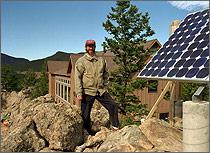Operating Your System Off-Grid

Stand-alone systems can be more cost-effective than connecting to the grid in remote locations.
Photo credit: Dave Parsons.
For many people, powering their homes or small businesses using a small renewable energy system that is not connected to the electricity grid—called a stand-alone system—makes economic sense and appeals to their environmental values.
In remote locations, stand-alone systems can be more cost-effective than extending a power line to the electricity grid (the cost of which can range from $15,000 to $50,000 per mile). But these systems are also used by people who live near the grid and wish to obtain independence from the power provider or demonstrate a commitment to non-polluting energy sources.
Successful stand-alone systems generally take advantage of a combination of techniques and technologies to generate reliable power, reduce costs, and minimize inconvenience. Some of these strategies include using fossil fuel or renewable hybrid systems and reducing the amount of electricity required to meet your needs.
The topics below provide more information on issues involved in setting up a stand-alone system. Your local system supplier or installer, a local renewable energy organization, or your state energy office should be able to help you navigate the specific requirements in your community.























